She already had a high-risk pregnancy. Then, COVID-19 struck.
This story was produced as part of a larger project led by Marina Riker, a participant in the 2020 Data Fellowship.
Her other stories include:
Birth in the time of coronavirus
It's one of the silver livings': How COVID-19 pandemic could boost access to maternal health care
Part 1: Birth on demand
Part 2: More than ‘a little snip’
Texas lawmakers aim to make maternal health a priority this year
Part 3: Filling The Gap
Our women are dying': Texas lawmakers urged to extend Medicaid to a year after birth for new mothers
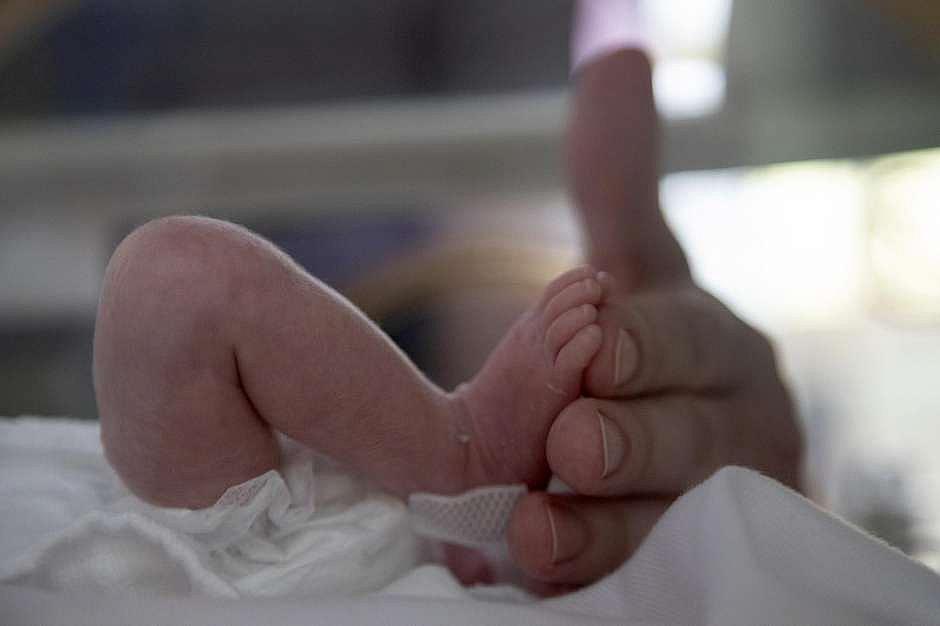
When touching the twins, Colton and Alysia apply steady pressure so they don’t overwhelm the infants with the sensation.
Photo: Lisa Krantz /Staff photographer
The house was quiet and the cribs were empty when Alysia and Colton Ford arrived home, three days after she was rushed into emergency surgery to deliver her twin boys.
Alysia was only 26 weeks pregnant. She’d been diagnosed with COVID-19 about two weeks earlier and spent more than a week in the hospital fighting the disease.
Twenty-four hours later, the baby’s heart rate became unstable. On July 23, doctors performed an emergency cesarean section.
The newborns, delivered three months before their due date, were rushed to the neonatal intensive care unit at Children’s Hospital of San Antonio — so quickly that Colton barely caught a glimpse of them. Alysia could only hear their cries.
Because Alysia was still recovering from COVID-19, she wasn’t allowed to visit her sons in the NICU until she finished the COVID-19 quarantine and wouldn’t pose a risk to the babies and staff.
Colton would have to meet their sons for the first time, alone.
A baby blanket is draped over the top of Drake’s isolette, shielding him from stimulation in the outside world. Photo: Lisa Krantz /Staff photographer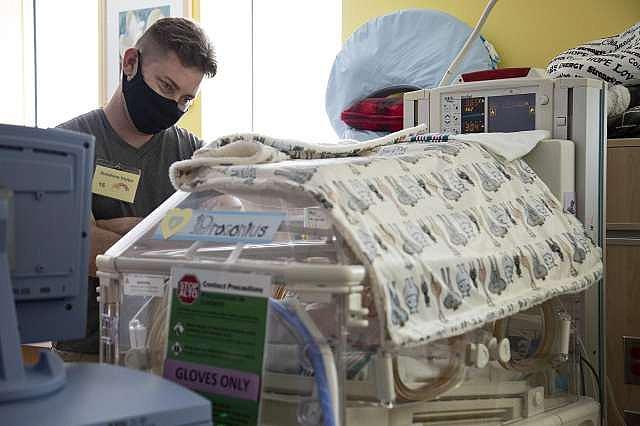
Since COVID-19 was a new disease, there wasn’t enough data to understand how it affected pregnant women. But what was clear in the beginning of the pandemic — and early in Alysia’s pregnancy — was the sudden change to visitor policies at doctors’ offices and hospitals, aimed at slowing the spread of the virus.
Colton said he was allowed to attend only one out of roughly 20 sonograms. Otherwise, he waited in the car while Alysia attended appointments with her regular obstetrician and high-risk pregnancy specialist.
Alysia, 36, and Colton, 31, met while stationed overseas with the Air Force nine years ago and had been trying to have a baby for nearly five years — an effort that had included many losses. During her first pregnancy in 2017, Alysia developed a life-threatening complication and the baby died within hours of her premature birth at 23 weeks. Two and a half years later, her second pregnancy ended in a miscarriage.
The Fords then decided to try in vitro fertilization. By early February, Alysia was pregnant. Her due date was Oct. 28, their eighth wedding anniversary.
It had been a relatively smooth pregnancy. Until one day in early July when Alysia’s foot went numb. She feared she might be experiencing a blood clot.
The Fords rushed to a San Antonio emergency room — at the height of the city’s spike in coronavirus hospitalizations, when government officials feared hospitals would run out of beds.
Doctors checked Alysia. Nothing was wrong. But a few days later, she came down with COVID-19.
She spent more than a week in University Hospital. Colton also contracted the virus but had much milder symptoms and recovered at home.
Breathing — let alone, talking — was so difficult that Alysia couldn’t call her husband and had to text him updates from her bed. She was unable to eat through most of her stay because she was on the verge of needing a ventilator to breathe.
“They were scared they were going to have to intubate me,” she recalled.
As the coronavirus pandemic began to unfold, doctors didn’t know whether it would hit pregnant women harder, as was the case during previous flu outbreaks and the H1N1 pandemic in 2009. Pregnant women accounted for 5 percent of all of U.S. deaths during that pandemic, even though they made up just 1 percent of the population, according to the Centers for Disease Control and Prevention.
Alysia’s due date was Oct. 28, her and Colton’s eighth wedding anniversary. Photo: Lisa Krantz /Staff photographer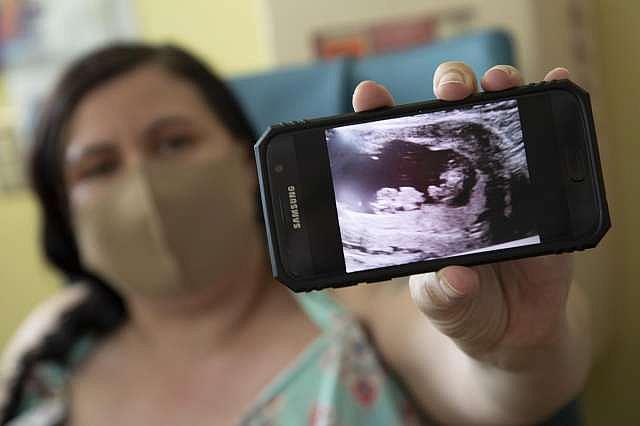
Dr. James Hill, the maternal fetal medicine specialist at Children’s Hospital of San Antonio who served as Alysia’s high-risk pregnancy specialist, said hormonal changes during pregnancy alter a woman’s immune system, increasing the risk for infections.
While the baby is developing, the mother’s lungs, blood vessels and muscles are under additional stress — the same systems attacked by COVID-19. At the same time, the uterus presses up on a woman’s diaphragm as the baby grows larger, making it harder for her to clear fluid from her lungs at a time when she needs to consume more oxygen.
One recent study examining COVID-19 cases from China, Italy and the U.S. suggested that anywhere from 3 to 7 percent of pregnant women with the disease can end up being admitted to intensive care units, Hill said.
“Pregnant women have these immunological and physiological changes that make them more susceptible to respiratory infections,” Hill said.
The CDC recently found that, even when adjusting for age and underlying conditions, pregnant women afflicted with COVID-19 during the first few months of the pandemic were 1.5 times more likely to need intensive care and 1.7 times more likely to need ventilators to breathe than women who weren’t pregnant.
And, similar to the general population, in which people of color are at higher risk, pregnant women who are Black or Latina also appear to be disproportionately harmed by the disease, according to the CDC.
At University Hospital, Alysia underwent breathing treatments, steroids and IV therapies. Nurses carefully monitored the twins’ heartbeats, one time staying by her side the entire night. After more than a week, she was stable enough to go home.
But at her next pregnancy checkup, six days after she was discharged, her doctor found that one of the twins hadn’t been growing properly since Alysia contracted COVID-19.
The babies’ best chance of survival, her doctor said, was outside of their mothers’ womb.
Draconius is the larger twin and about one minute older than his brother. Photo: Lisa Krantz /Staff photographer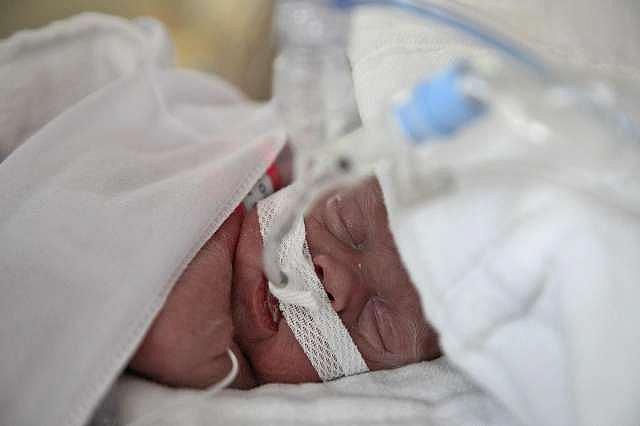
The twins were so small when they were born that doctors weighed them in grams.
Draconius “Drake” Blaze Ford, the oldest by a minute, weighed 980 grams — about 2 pounds, 3 ounces. Keenen Legend Ford, who hadn’t been growing properly, weighed 810 grams — about 1 pound, 13 ounces. The average birth weight in the U.S. is around 7 pounds.
By mid-August, the Ford twins had been there for nearly three weeks.
“It’s a great day in the NICU,” the nurse chimed one day. “Do you notice anything different?”
Keenen, the smallest, was now able to rely on a normal ventilator. A few days earlier, he’d gone into septic shock and needed an oscillator to survive — a special machine that gives him hundreds of small breaths each minute, instead of just 30.
“Hey Keenen, mom and dad are here, bud,” Alysia cooed, standing over the isolette and lifting a corner of the baby blanket covering it to peer at her son. “You look a lot better today. We see you got the blue respirator.”
“He looks a million times better,” Colton said. “So much better, dude.”
“Mom and dad love you, buddy,” Alysia said.
“The NICU roller coaster,” Alysia and Colton call it. One day, it’s a rush of hope and joy as they hit a milestone, like the twins being able to consume breast milk through a feeding tube instead of getting all their nutrition from an IV. The next, feelings of anxiety and uncertainty as they rush to the hospital, called by the nurses in the middle of the night.
The Fords keep blankets and neck pillows at the NICU for the bad days. They stashed snacks in a break room fridge for when they get hungry in the middle of the night when the hospital’s cafeteria is closed. When things have gone wrong — like when Keenen developed a sudden infection and needed exploratory surgery to locate it — they've waited at the hospital as long as 14 hours.
It’s a tumultuous journey that parents face when newborns need weeks, and sometimes months, in intensive care to survive. Across the country, nearly one in 10 babies are born premature, a rate that rose for the fourth straight year in 2018, the most recent year the CDC has available. When the number of preterm births rise, so, too, do NICU stays. For babies born at less than 32 weeks, the average cost of a hospital stay can exceed $280,000.
Premature babies like the Ford twins are at higher risk of long-term health problems such as chronic lung disease and developmental delays. For now, they’re also more susceptible to infections and have higher risks of brain bleeds.
Even with the most advanced medical care, it’s much harder for infants to develop outside the womb.
Dr. Maria Pierce, the medical director for the Children’s Hospital’s NICU, said the Ford twins are getting around-the-clock support from highly-trained nurses, developmentalists, physical therapists and occupational therapists.
“The boys are fighting a gallant fight,” Pierce said. But only with time will she and other members of their medical team begin to understand the long-term effects of their early birth.
The question that looms over Alysia and Colton is to what extent COVID-19 played a role.
Hill, Alysia’s maternal fetal medicine specialist, said emerging data shows the disease might lead to a higher risk of pregnancy complications, including preterm birth. One recent study of about 540 pregnancies found that the preterm birth rate was about 20 percent — nearly twice the rate for U.S. women without COVID-19.
Both twins needed machines to pump oxygen into their lungs. Electrodes stuck to their bodies, monitoring their heart beats. A blood pressure cuff wrapped around a calf; a blood oxygen reader over a foot. Semi-permanent IVs carried nutrition and medication through their blood.
By early September, Drake was stable enough that he didn’t need a ventilator anymore. Photo: Lisa Krantz /Staff photographer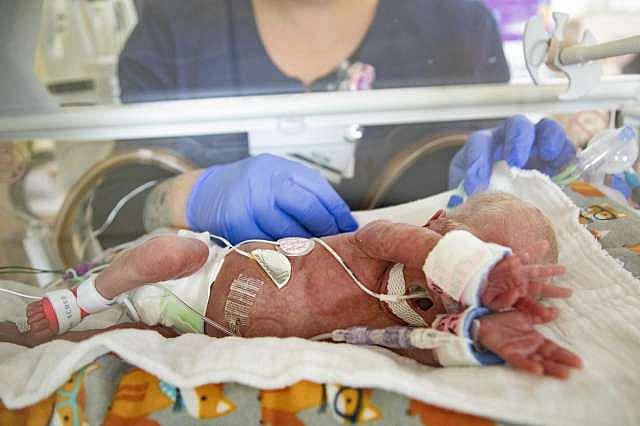
Hill said most of the women in that study were from China. Because obstetric practices vary among countries, that information is still too limited to be able to show exactly how COVID-19 affects pregnant women in the U.S. It’s even more sparse when focusing on women who already had high-risk pregnancies like Alysia.
“You worry about whether this whole pregnancy was affected by COVID-19, and if the reason why we delivered her was related to that,” Hill said. “I wish I knew, because it would be nice to give her that information, but we just don't know that.”
Alysia had two other strikes against her: She was carrying twins, who are more likely to be born prematurely, and she had a history of a rare and dangerous complication during a past pregnancy. Called HELLP syndrome, the disease can destroy red blood cells and the liver can bleed internally, killing women or causing health problems for the rest of their lives.
Until they have more answers, there’s no way of knowing whether COVID-19 was one of the reasons Keenen wasn’t growing in her womb.
By the time the twins were six weeks old, Drake’s torso was the size of the nurse’s hand, his tiny arms and legs just a little wider than her fingers.
She gently scooped up Drake, lifting him out of the protection of the isolette and gently setting him down on his father, sitting shirtless in a recliner. Colton positioned one hand under Drake’s diaper and the other on his back, stroking him gently to soothe him as the nurse adjusted the electrodes and wires monitoring the baby’s heart and breathing, still connecting him to the machines and isolette.
Next, it was Alysia and Keenen’s turn. For weeks, she had stared at both her babies in their isolettes, desperately wanting to hold them. But the logical side of her brain knew they were too fragile and needed the protection of the medical equipment to survive. So she’d sit next to their tiny hospital beds, opening one of the isolette’s portal windows and reading passages from children’s books that loved ones gave them. Other times, she’d read a chapter from “Golem in the Gears,” the ninth book in the Xanth fantasy series.
But that day, for the one of the first times since they entered the world, both Keenen and Drake were stable enough that Colton and Alysia could hold the twins at the same time.
So the nurse repeated the same steps — carefully gathering the wires and tubes so they didn’t pull out before she lifted Keenen, placing him on Alysia’s chest, with the lower part of his body tucked underneath her t-shirt. Skin on skin.
“You’re OK, buddy,” she cooed. “Mom’s got you.”
Keenen was born on July 23, roughly three months early. Photo: Lisa Krantz /Staff photographer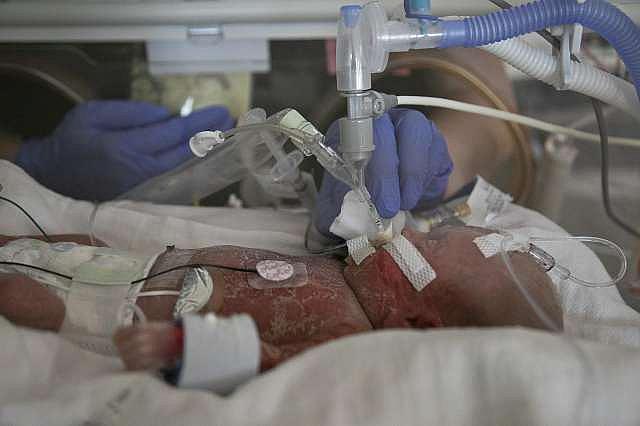
Keenen was still so little that when resting on Alysia’s chest, his face dipped below her chin and she couldn’t see him when looking down over her face mask. With one hand, she gently held him on her chest, and with the other, a hand mirror so she could gaze at his face.
As the baby slept, she thought about how thankful she was that he was still here. She felt his heart beat through her skin, the rise and fall of his chest with each tiny breath.
“Someday,” she told him softly, “you’ll be big enough to breathe all on your own.”
[This story was originally publised by San Antonio Express-News.]
